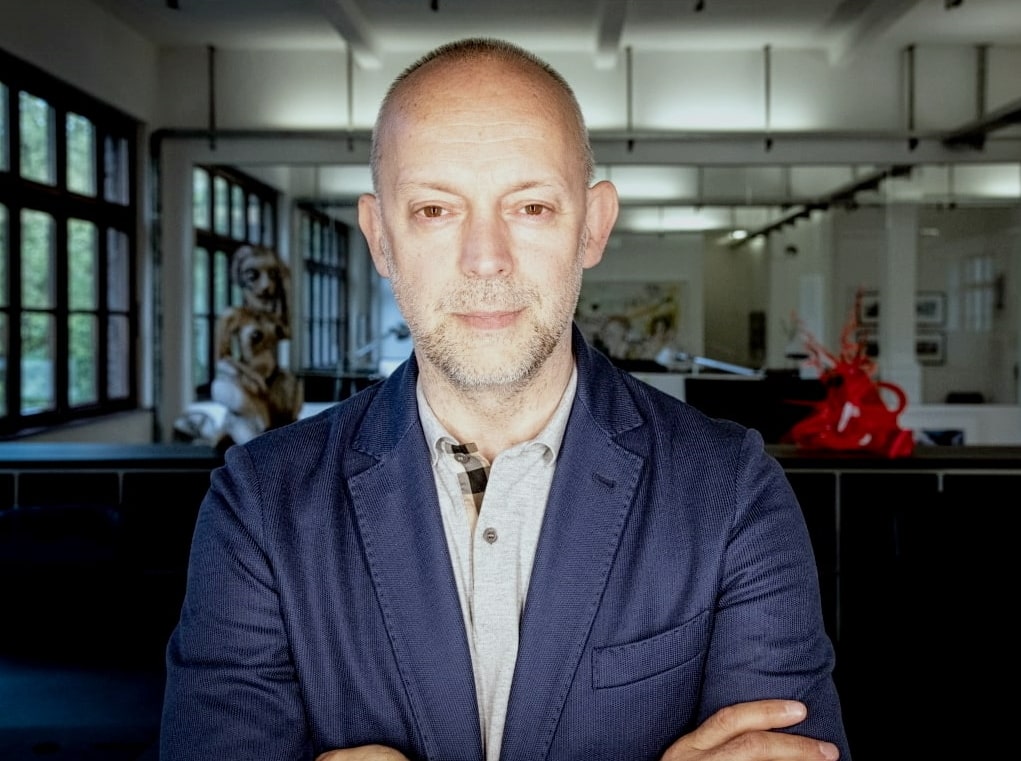Just as, according to Joseph Beuys, there is an artist in everyone, there is also a collector in everyone. It is probably in our genes that we surround ourselves with things that give us security and permanence, that beautify or enhance our surroundings, that fulfil a certain purpose – or not, that make us remember or think of something, that stimulate our imagination or inspire us, or that simply please us. Most of the time, what we collect is not art. Although art is probably one of the best things you can collect. Because there are many good reasons for living with art. And you don’t have to become a traditional art collector to experience, enjoy and benefit emotionally from the positive effects of living with art.

Stephan Balzer, Photo: André Remark
If you had the choice, where would you rather spend an evening: In a restaurant with plastic flowers and electric tea lights on the table and art prints on the wall, or in a restaurant with fresh bouquets, candles and original artwork? Naturally, we feel more attracted to the real and valuable than to any mass-produced goods. Only the real thing gives us the positive feeling of being connected to life. But then why do so few people decide to buy art, whether contemporary or modern art? For art does not necessarily have to be expensive or elitist. We interviewed two Berliners who surround themselves with art and no longer want to do without it in their lives, and asked them about their personal motives. Both have been loyal to contemporary art for decades. We would like to tell you about their motives, their passion and the meaningfulness of engaging with and acquiring contemporary art.
„LIVING WITH ART IS IMMENSELY ENRICHING BECAUSE CONTEMPORARY ART ALWAYS RAISES QUESTIONS.”
Manfred P. Herrmann, Tax consultant + art lover, 2021
Art not only exudes the appeal of owning something beautiful. Art is also an attitude to life, inspiration, investment and exchange. For Stephan Balzer, born in 1966, Berlin-based entrepreneur, speaker and consultant, a central reason for dealing with and surrounding oneself with art is pure pleasure: “It has a lot to do with pleasure, I’m a very pleasure-oriented person, I like to live very much: good food, fun, and art is also part of it for me. “* He describes it as a feeling that is downright contagious: “It’s the kick for the brain that I give myself, and that won’t change. I got this beautiful art virus years ago, and I don’t want to get rid of it either. “* Balzer made these statements 11 years ago now, and they still hold true for him today. In his daily experience of living with art, it is the content aspect that is important to him – not the decorative aspect: “I am surrounded by art every day, both at home and in our office, and I can’t imagine what it would be like without it. Decoration has never played a role, but rather the possibility of capturing a moment in our history, so here the artist’s reflection on society and our environment as a document of time and interpretation.”

Stephan Balzer and his wife Elena Kaplyar-Balzer, Photo: André Remark
Art lovers experience this stimulating (thought) exchange in many forms. Be it as an inner dialogue with the work, or quite directly as a conversation with the gallery owner at a vernissage, with the artist during a studio visit, in conversation with other art enthusiasts at fairs or within one’s own four walls when a visitor addresses one about a work. This is also confirmed by our second interviewee, Manfred P. Herrmann, born in 1948, tax consultant and partner in the tax office HPTP in Kreuzberg: “Living with art is immensely enriching because contemporary art always raises questions. We not only have a lot of art at home, but also in the office. It is particularly interesting to see how the staff react to it, and also the guests in the office – or at home. It always leads to conversations that you wouldn’t have otherwise.”
“ART MUST BE INCLUSIVE AND ACCESSIBLE TO ALL PARTS OF SOCIETY.”
Stephan Balzer, Entrepreneur + art lover, 2021
If living with art is so stimulating, why are only a maximum of 7.23% of Germans more intensively interested in it? (Source: statista.com, Interest of the population in Germany in the art and culture scene, 2020) It may well be due to the persistent prejudice that art is elitist and only something for intellectuals or high society. Where does this view come from and how can the misunderstanding be cleared up? “I would counter this thesis by saying that it shouldn’t be, because in parts this corresponds to reality today,” says Stephan Balzer. “Art must be inclusive and accessible to all parts of society. I think we’re talking about a cultural phenomenon that has developed over many years, it has promised interested people supposed access to these intellectual and high society circles through art.” He continues, “I think we still have threshold fears in the general population when it comes to engaging with the subject of contemporary art and galleries. But I’m not sure that the market or the galleries should have the task of becoming more accessible. In my opinion, it should rather be the museums, the art halls, because there is much more potential there. Compared to some other countries, I find the offerings of many museums in Germany too narrow and even elitist in parts. I hope that something will change when the next generation of museum makers takes the helm. I think here too: a change is going to come.”
„ART IS MADE BY PEOPLE FOR PEOPLE. OF COURSE, THIS AREA OF HUMAN CULTURAL ACHIEVEMENT IS NOT ENTIRELY SELF-EVIDENT AND HAS TO BE WORKED OUT. BUT THAT IS NO DIFFERENT, FOR EXAMPLE, WITH THE RULES OF FOOTBALL.“
Guido W. Baudach, Gallery owner, 2021
For Manfred P. Herrmann, the clue lies in the attitude towards art, not in the size of the individual budget: “It’s a question of interest, you can also deal with art without spending money, you just have to visit the museums and galleries … And there is also good art that costs little. However, you have to deal with art, that requires time and interest.” But what to do when time and interest are available but you don’t quite know where to start? “Join a good support association for contemporary art, e.g. Stoberkreis Nationalgalerie, KW, Berlinische Galerie, etc.,” Herrmann advises. “You learn a lot about contemporary art there. Then you should visit young galleries with gallery owners who are about the same age as the young art buyer.” Stephan Balzer recommends that young art enthusiasts spend a lot of time in galleries and museums, see a lot and discover themselves and also their own preference through this.

Manfred P. Herrmann during an art event, 2013, Photo: Privat
In addition to all the emotional added value, however, art is also known to be an interesting investment object. Manfred P. Herrmann’s expert opinion: “If you buy well, you can certainly invest your money very well. But there will always be cases where you are a little off the mark, so investment should never be the sole motive for collecting. However, the same can happen with real estate or shares. It’s legitimate to see art as a value because you also spend a lot of money on it. It’s not just about having something beautiful on the wall, but also about preserving the values. You have to (…) get good advice. “* Stephan Balzer’s closing words make us feel active: “I can only recommend this to anyone who hasn’t seen that much art yet: Start with it, it’s extremely fun. People who only have a small budget can collect contemporary art from artists who are around us, who enrich our lives with their work. “*
The interviews with Stephan Balzer and Manfred P. Herrmann in full lenght. Both interviews have been conducted in German language.
Preface & text editing: Stephanie Schneider
*All quotations so marked from: KUNST Magazin Sammlergespräche, geführt von Jan Kage (2010), Hg.: Jennifer Becker & Stefan Haupt, Offizin Zürich Verlag, 2013
This post is also available in: Deutsch

